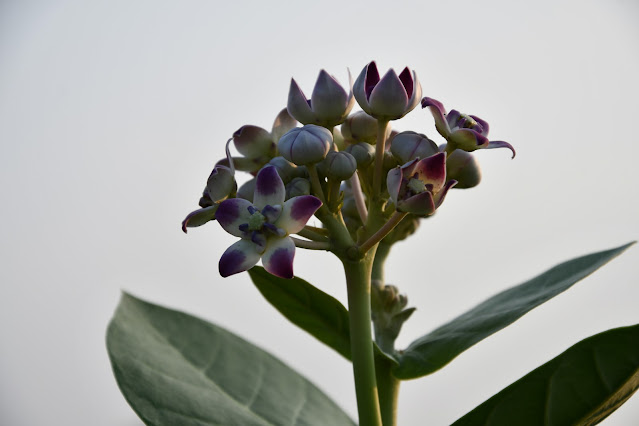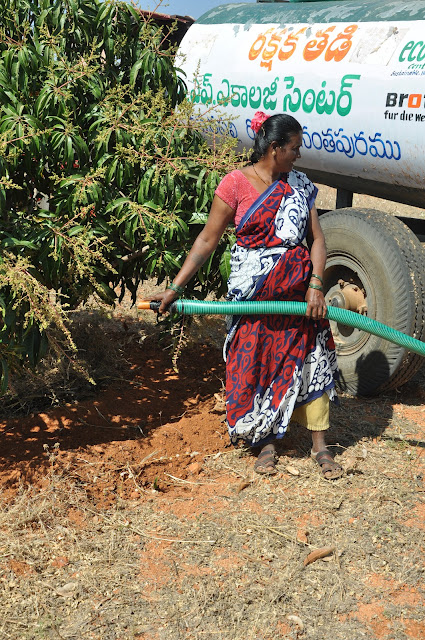Dryland Agriculture is the key to watershed management!
Anantapur district’s recovery from chronic drought and significant success in reversal of the process desertification needs a revisit.
The debilitating nature of repetitive droughts caused repeated famines because of crop loss triggered by missing monsoons. "According to Government records 18 years in the new millennium of 21 years have been drought hit" says Dr. Malla Reddy Director of Accion Fraterna Ecology Centre an NGO accredited by the Government of Andhra Pradesh to combat desertification in Anantapur.
Enterprising rural women have successfully availed of the benefits of Women Groups self-managed micro finance interventions too… running small businesses, making traditional snacks like milled flour fryums, confectionaries etc. Another unexpected offshoot has been that these kind of traditional nutritive snacks helped improve the iron content in the blood supply of children and the villagers in and around Kalyandurg. People suffering from endocrine disorders like diabetes and hypertension have found relief by eating native nutrition like millets – which are low in carbohydrates; they order the traditional foods from these women who are funded by the micro finance women’s SHGs.
Accion Fraterna Ecology Centre in Anantapur is an NGO working on drought mitigation and improving local agroecology. Led by Dr. Malla Reddy a senior environmental worker, AFEC lent its expertise to mitigate drought and climate change and combat desertification through agro ecological interventions, including:
Restoration of agro-forestry by raising rain-fed horticulture plantations where fruit farmers became stakeholders in creating rich leaf litter, woodlots too helped sicker the meager rainfall to the top soil. Rainfed horticulture not only helped mitigate drought but with climate resilient horticulture watersheds or fruit orchards the ground water table was replenished. AFEC has established over 8,333.33 hectares of rain-fed horticulture benefitting 10,000 farmers in the past 30 years in 6 Mandals or district subdivisions in Anantapur district of Andhra Pradesh: Settur, Kundurpe, Atmakur, Kalyandurg, Kuderu and Raapthadu Mandals of Anantapur district.
Ground water was replenished through various rain water harvesting techniques like contour bunding, bund plantations, farm ponds construction of check dams, rain water gabions, percolation tanks, and managing the rainwater in synch with local hydrology. The groundwater levels increased from pre-project level of 52 Meters below ground level to 20 Meters post-project.
“Accion Fraterna Ecology Centre in Anantapur understands the factors that trigger desertification and moisture stress and evolved out of the box solutions and interventions with emphasis on farmers participation. Planning at village level involves net-planning as well as catchment level planning. Net-planning involves activities to be taken up at each farm holding level like soil & moisture conservation, farm ponds, farm forestry, planting of fruit trees etc. Net-planning has to be done with combining indigenous knowledge with science and informed participation of the farmer, so that the farmers maintain and sustain the activities at holding level. Catchment level planning mainly involves rain water harvesting structures like check dams, tree plantation in common lands, protecting the traditional water bodies and pasture lands development”. AFEC covered with treatment, an area of 145,833.33 hectares with such integrated approach of net planning and landscape planning” said Dr. Malla Reddy in an exclusive statement given to Digital Discourse Foundation.
Accion Fraterna Ecology Centre Intensively promoted native food crops (millets, pulses, oil seeds) which are Climate resilient for Climate Smart agricultural initiatives - an urgent need of the hour, in view of not only climate change, but also to boost food & nutritional security in the desertified landscape where once malnutrition stalked.
Another very, very interesting, intervention had gender inclusiveness at its core: Women were supported financially in Micro Finance self help groups to take up non-farm income generation activities. This alternate income activities help them to provide livelihood security and enhance their self-worth and status in society. Women beneficiaries of the Micro Finance Self Help Groups called SHGs are now able to earn more to supplement farm incomes of their families. Such activities include petty businesses, garment business, millet snack shops, livestock, dairying etc. Dryland native crops including groundnuts, pulses and millets which are not water hungry crops were always ideally suited for rain shadow areas like Anantapur. Women who have been trained in baking millet flour-based confectionary, short eats and traditional snacks now take orders for these millet flour-based confectionary, short eats and traditional snacks, prepare and sell them; thus, successfully augmenting their meagre farm income.
Climate Change and soil erosion were factors in desertification too in Anantapur District. According to district administration officials in the District Watershed Management Agency (DWMA) and environmental activists, the ground water had depleted to 900 feet or 300 metres below the ground in some places (depending on the hydrology of the place), thanks to unsustainable ground water exploitation, without regard for recharging the ground water. This has now been stymied.
Barren arid landscapes have been turned into lush green sandscapes with agro-ecologocial interventions of AFEC, in watershed villages in over 300 villages in Anantapur District since 1985. AFEC has undertaken re-greening 70 hill slopes in the hilly hinterland of Anantapur. It has quite literally increased the ground water table from 52 metres below the ground to about 20 metres below the ground. That is no mean achievement!
With zero budget natural farming the special focus that Accion Fraterna Ecology Centre lent was agro-ecological intervention for sustainable agri-production and restore agro-ecology of the villages. The initiative in effect helped farmers towards Climate Change Mitigation and Adaptation. Dry land farming or drought resilient agriculture always revolved round traditional crops and foods. Dryland farming meant cultivation of those crops which do not need much water… like millets, oilseeds, lentils, pulses and even mango orchards which can thrive on rainfall only – without irrigation infrastructure.
India's Food Revolution - that emphasized food security - popularised food crops like only rice and wheat at the cost of neglect of native, dryland and Climate resilient crops like millets, oilseeds, and lentils. The trade off was loss of a) agri-bio diversity, b)local food diversity and c) nutritional security.
Water hungry crops like rice or cool-climes-friendly crops like wheat, are arguably not meant for dry arid zones like rain starved, moisture-stressed Anantapur! Obviously.
Climate Smart Agriculture is all about being practical, it seems, from AFEC’s perspective. AFEC undertook Climate Smart Agriculture by going Native, so to say. AFEC encouraged and husbanded native crop cultivation that suits the Micro Climate naturally… Millets and oilseeds and Foliage rich tree species which can thrive in dry arid climatic zones without a need for irrigation infrastructure.
These kinds of native crops are native nutrition in this climatic zone and all culinary traditions too quite literally harvest the native crops. That gave the farmer and the entire district’s populace a ready acceptance of Climate Smart Agriculture. Further, native Dryland crops like millets and oilseeds complement the health quotient bring an element of agro meteorological culinary comfort quite literally negating the monopolistic agricultural regimen initiated by the Food Revolution of 1969. Thus AFEC’s Climate Smart Agriculture initiative helped in ameliorating the onset of endocrine disorders with State supported carbohydrate consumption, so to say.
Do watch the Dr. Y.V. Malla Reddy's full length interview:
Beneficiary farmers like Ramakrishna Reddy in the Yerragunta Village of Raapthadu Mandal, Anantapur District Andhra Pradesh (where the Accion Fraterna Ecology Centre has undertaken interventions to raise the ground water table) today agree that the ground water table has risen. “As now there are ample rains, ground water is available even at 100 to 150 feet or about 16 metres below the ground. Now with replenishment of ground water table, migration of daily wage earners to Hyderabad, Bangalore and Chennai has not only stopped but people have started returning to Anantapur.”
The secret to success of enhancing tree cover by AFEC has been in planting drought tolerant, fruit orchards of tropical fruits (mango, custard apple, guava, gooseberry, Jamoon fruits, Citroen, Ber, Pomegranate, some varieties of jackfruit (like dwarf varieties of jackfruit)... all of which will survive arid conditions.) Not just survive arid conditions, but they are dependable source of livelihoods. The leaf litter and mulch from these native trees permeate the porous soil rendering the top soil fecund even in the absence of a riparian ecosystem anywhere nearby...
 |
| Growing millets was encouraged by the government and agricultural research bodies. |
 |
| A groundnut / peanut farmer battles the weather while harvesting dryland crop - groundnut / peanut is native to dryland areas like Anantapur which is frequented by droughts famine and desertification. NGO advocated Climate Smart Agriculture or dryland farming in deference to the endemic weather conditions. Ground nut crops need little water and moisture. So instead of struggling to lay elaborate irrigation infrastructure for water hungry crops like rice the government and NGOs went in for "Climate Smart Agriculture" encouraging native crops like millets, oilseeds, etc that can withstand chronic drought. NGOs like Accion Fraterna Ecology Centre (AFEC) started micro finance schemes to help such women farmers not only harvest native dryland crops like groundnuts and millets but trained them in maling traditional snacks and to sell them to supplement their families' farm income. Native dryland crops like millet and millet based sacks in turned out was a tremendous public health boost too, as their are helpful to those fighting endocrine disorders like hypertension and Diabetes Miletus. Their snack making business is turning out to be a win-win solution as well as helping women agricultural labourers supplement their modest farm income. |
 |
| Hills that have been unsustainably mined are getting a green glow in their environs thanks to intense watershed management. |
 |
| This is an lentil farm I saw a peacock strode across this farm! |
 |
| Gooseberry tree's leaf litter enriches soil moisture and restores nutrition. |
 |
| Taming the earth to obtain nutrient rich soil moisture in a desertified landscape fit for cultivation of fruit orchards is certainly no mean task! |
 |
| The sheer profligacy of mango varieties in the Subcontinent's varied climatic conditions creates awe! |
 |
| A woman mango farmer... such perceptive schemes have given financial, and social security t marginalised women farmers in India. |
 |
| Here's a young woman harvesting fruits from her small farm holding in the Kundurpi Mandal of Anantapur district. |
 |
| Imagine carrying organic biotic litter or mulch on bullock carts. How much more climate smart can you get? |
 |
| Pomegranates are encourages for backyard plantation by the Andhra Pradesh Rytu Saadikara Samstha in aid of organic farming. |
 |
| Passion Fruit! |
 |
| Minor millets and oil seeds |
 |
| Living off a land of plenty |
 |
| Mango varieties in India breach the horizon of imagination. A hardy species it is an evergreen tre that can survive in desert landscape as well as rainfall rick areas. |
 |
| Found myself in sheer awe of this green canopy in a Papaya plantation. Who can believe that this is in dry arid, drought hit desertified Anantapur? |
 |
| She is the picture of a very happy vegetable farmer! |
 |
| Masoor Dal or red gram is a favourite in Indian Dals... Its an example of plant protein for vegetarians. |
“The oncept agro-ecology
is taken from the natural forest: it advocates that the farm land should not be
exposed to direct sunlight, direct rain or direct wind. So, the farm land
has to be kept covered with multiple crops for 365 days in a year. This
nurtures the biotic life of the soil, prevents soil-moisture evaporation, and
builds sustainable soil productivity in a natural manner” says Dr. Malla Reddy
in an exclusive statement given to Digital Discourse Foundation.






































































































Comments
Post a Comment